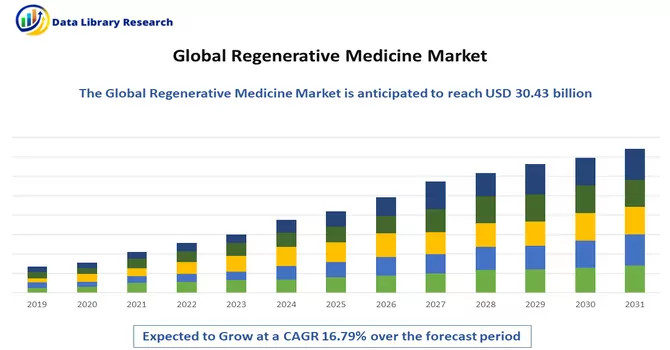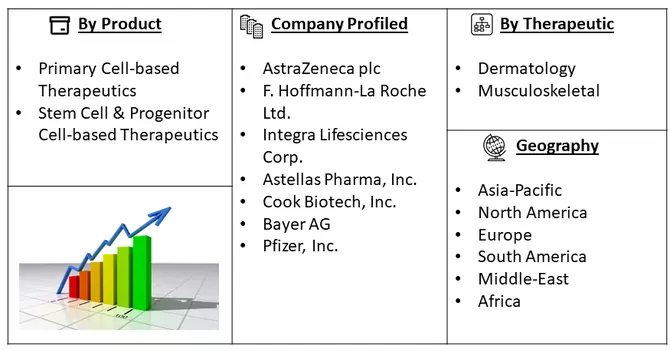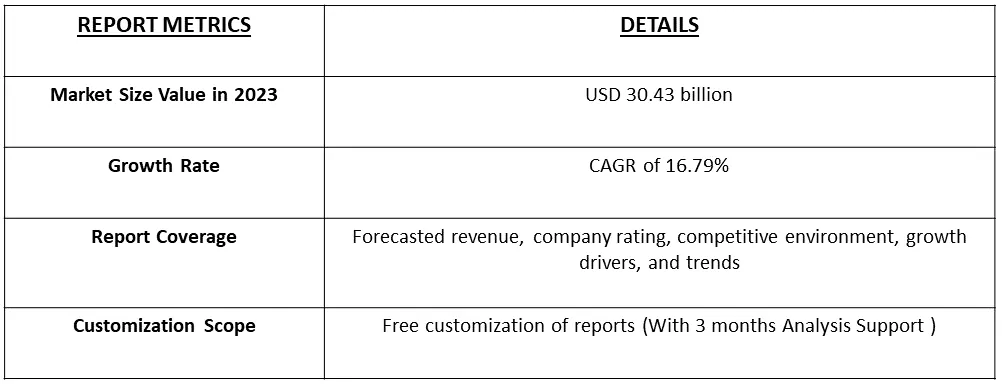The global regenerative medicine market size was estimated at USD 30.43 billion in 2023 and is expected to grow at a compound annual growth rate (CAGR) of 16.79% from 2024 to 2030.

Get Complete Analysis Of The Report - Download Free Sample PDF
Regenerative medicine is a multidisciplinary field of biomedical science focused on harnessing the body's natural ability to repair, replace, and regenerate damaged or diseased tissues and organs. It employs various approaches, including stem cell therapy, tissue engineering, gene therapy, and the use of biomaterials, to stimulate the body's inherent regenerative processes. The ultimate goal of regenerative medicine is to restore normal structure and function to tissues and organs affected by injury, disease, or aging. This field holds significant promise for developing innovative treatments and therapies that go beyond traditional approaches, aiming to address the root causes of medical conditions and promote long-term healing
The factors that are driving the growth of the studied market are the recent progress in biological therapies has prompted a gradual preference shift toward personalized medicinal strategies as opposed to conventional treatment methods. This shift has opened up opportunities for companies engaged in the development of biological therapeutics. Additionally, the growing incidence of degenerative disorders has heightened the emphasis on research aimed at uncovering innovative regenerative therapies.
There is a growing emphasis on research and development activities in regenerative medicine. Ongoing exploration of stem cell therapies, tissue engineering, and gene therapies contributes to the expansion and diversification of the regenerative medicine market. Artificial intelligence is being integrated into regenerative medicine research and development processes. AI-driven algorithms and analytics contribute to the identification of potential therapeutic targets, optimization of treatment protocols, and predictive modeling. These trends collectively shape the regenerative medicine market, indicating a dynamic and promising future for the development and application of regenerative therapies in various medical fields.
Market Segmentation: The Regenerative Medicine Market is Segmented By Product (Primary Cell-based Therapeutics, Stem Cell & Progenitor Cell-based Therapeutics), By Therapeutic Category (Dermatology, Musculoskeletal), and Geography (North America, Europe, Asia-Pacific, Middle East and Africa, and South America). The report offers the value (in USD million) for the above segments.

For Detailed Market Segmentation - Download Free Sample PDF
Market Drivers. :
Presence of a Strong Pipeline and a Large Number of Clinical Trials
Regenerative medicine is witnessing an extensive array of clinical trials across different phases, highlighting the commitment to translating promising therapies from the laboratory to clinical applications. These trials encompass a spectrum of therapeutic areas, including neurodegenerative disorders, cardiovascular diseases, orthopedics, and autoimmune conditions. The regenerative medicine pipeline spans a diverse range of therapeutic applications, reflecting efforts to address various medical challenges. This diversity includes treatments for degenerative diseases, organ failure, genetic disorders, and injuries. The collaborative nature of regenerative medicine is evident in the involvement of academic institutions, biotechnology companies, and pharmaceutical organizations in clinical trials. Collaborations foster a collective approach to advancing the field and bringing novel therapies to patients. Thus, the market is expected to witness significant growth over the forecast period.
Emerging Applications of Gene Therapy in Regenerative Medicine
Gene therapy is being explored for musculoskeletal regeneration, particularly in the context of orthopedic conditions and injuries. Strategies involve the delivery of genes encoding growth factors or signaling molecules to enhance bone and cartilage regeneration. This has implications for treating fractures, osteoarthritis, and other musculoskeletal disorders. Regenerative medicine, gene therapy contributes to cancer immunotherapy. Genes encoding chimeric antigen receptors (CARs) are introduced into immune cells to enhance their ability to recognize and eliminate cancer cells. Thus the market is expected to witness significant growth over the forecast period.
Market Restraints.:
Regulatory Issues Pertaining to Stem Cells, Tissues Engineering, and Regenerative Medicines
Regulatory agencies face the challenge of developing rigorous standards for assessing the safety and efficacy of stem cell, tissue engineering, and regenerative medicine products. Ensuring that these therapies undergo thorough preclinical and clinical evaluations is essential to mitigate potential risks and enhance patient safety. The proliferation of unproven and misleading claims related to stem cell therapies requires regulatory intervention. Establishing mechanisms to identify and address clinics or products making unsupported claims is essential to protect patients and maintain the integrity of the field. The growth of the market is expected to witness significant growth over the forecast period.
The pandemic prompted a temporary shift in research priorities globally, with a significant emphasis on understanding the SARS-CoV-2 virus, developing diagnostics, and exploring therapeutic options for COVID-19. This diversion of resources and attention may have affected ongoing regenerative medicine research projects. The rapid development of COVID-19 vaccines using innovative technologies, such as mRNA vaccines, showcased the potential for advanced biotechnological approaches. This acceleration may indirectly influence the acceptance and adoption of cutting-edge technologies in regenerative medicine. Thus, the COVID-19 pandemic has introduced challenges and opportunities for the field of regenerative medicine. While disruptions and delays were experienced, the crisis also highlighted the importance of innovative and personalized therapeutic approaches, potentially influencing the trajectory of regenerative medicine research and applications in the post-pandemic era.
Segmental Analysis:
Therapeutics Segment is Expected to Witness Significant Growth Over the Forecast Period
Therapeutics in the context of regenerative medicine encompasses a revolutionary approach to treating a variety of medical conditions by harnessing the body's inherent regenerative capabilities. Unlike traditional therapeutic modalities that primarily focus on managing symptoms, regenerative medicine seeks to repair, replace, or regenerate damaged tissues and organs. Stem cells are fundamental players in regenerative medicine, possessing the unique ability to differentiate into various cell types. Therapeutic applications involve the use of stem cells to replace or repair damaged tissues, with a focus on conditions such as degenerative diseases, spinal cord injuries, and cardiovascular disorders. Thus, the segment is expected to witness significant growth over the forecast period.
Oncology is Expected to Witness Significant Growth Over the Forecast Period
Oncology and regenerative medicine intersect at the forefront of innovative approaches to cancer treatment. Regenerative medicine, with its focus on tissue repair and replacement, offers promising avenues to address the complexities of cancer and its treatment. Cancer often leads to significant tissue damage either directly through the growth of tumors or indirectly through the side effects of treatments like chemotherapy and radiation. Regenerative medicine aims to repair and regenerate such damaged tissues, offering potential solutions for restoring normal tissue structure and function.
Moreover, in 2023, 1,958,310 new cancer cases and 609,820 cancer deaths are projected to occur in the United States. Cancer incidence increased for prostate cancer by 3% annually from 2014 through 2019 after two decades of decline, translating to an additional 99,000 new cases; otherwise, however, incidence trends were more favorable in men compared to women. For example, lung cancer in women decreased at one half the pace of men (1.1% vs. 2.6% annually) from 2015 through 2019, and breast and uterine corpus cancers continued to increase, as did liver cancer and melanoma, both of which stabilized in men aged 50 years and older and declined in younger men. Thus, the segment is expected to witness significant growth over the forecast period.
North America is Expected to Witness Significant Growth Over the Forecast Period
North America maintained its dominance in the market, as the leading position is primarily attributed to the availability of robust government and private funding for research and development, the presence of advanced technological frameworks facilitating the rapid detection of chronic diseases, and the region's substantial healthcare expenditure. The continuous support for regenerative medicine is evident in numerous ongoing clinical trials initiated by major market players.
A notable development in December 2021 was the U.S. FDA approval granted to Bristol Myers Squibb for Orencia, specifically for preventing acute graft versus host disease in adults, pediatric patients aged 2 years and above, and elderly patients undergoing hematopoietic stem cell transplantation (HSCT).
Furthermore, the recent development in the region is expected to expected to witness significant growth over the forecast period. For instance, in November 2021, Astellas Pharma, Inc. entered into an agreement with Pantherna Therapeutics GmbH to study mRNA-based regenerative medicine. Under this initiative, Astellas' high drug discovery capabilities and Pantherna's state-of-the-art mRNA platform will be used to promote research on developing a new program. Similarly, in May 2021 , Bayer AG entered into a collaboration with Senti Bio for gene circuit-engineered cell therapies development for regenerative medicine. Thus, such instances are expected to witness significant growth over the forecast period.

Get Complete Analysis Of The Report - Download Free Sample PDF
Key Regenerative Medicine Companies:
Recent Developments:
1) In October 2022, Astellas Pharma Inc. and Pantherna Therapeutics GmbH announced a technology evaluation agreement to develop mRNA-based regenerative medicine programs through direct reprogramming. Their collaborative effort aims to expand treatment options for diseases with high unmet medical needs by targeting new organs.
2) In July 2022, Mogrify Limited and Astellas Pharma Inc. announced a collaborative research agreement to develop regenerative medicine approaches for sensorineural hearing loss. Astellas Gene Therapies will fund the research and provide expertise in AAV-based genetic medicine, while Mogrify will leverage its bioinformatic platform for screening and validation to identify potential therapeutic factors. Their shared goal is to transform the lives of patients with hearing loss through innovative regenerative therapies.
Q1. What was the Regenerative Medicine Market size in 2023?
The global regenerative medicine market size was estimated at USD 30.43 billion in 2023.
Q2. At what CAGR is the Regenerative Medicine Market projected to grow within the forecast period?
Regenerative Medicine Market is expected to grow at a compound annual growth rate (CAGR) of 16.79% over the forecast peroid.
Q3. What are the factors driving the Regenerative Medicine Market?
Key factors that are driving the growth include the Presence of a Strong Pipeline and a Large Number of Clinical Trials and Emerging Applications of Gene Therapy in Regenerative Medicine
Q4. Which Region is expected to hold the highest Market share?
North America region is expected to hold the highest Market share.
Data Library Research are conducted by industry experts who offer insight on industry structure, market segmentations technology assessment and competitive landscape (CL), and penetration, as well as on emerging trends. Their analysis is based on primary interviews (~ 80%) and secondary research (~ 20%) as well as years of professional expertise in their respective industries. Adding to this, by analysing historical trends and current market positions, our analysts predict where the market will be headed for the next five years. Furthermore, the varying trends of segment & categories geographically presented are also studied and the estimated based on the primary & secondary research.
In this particular report from the supply side Data Library Research has conducted primary surveys (interviews) with the key level executives (VP, CEO’s, Marketing Director, Business Development Manager and SOFT) of the companies that active & prominent as well as the midsized organization
FIGURE 1: DLR RESEARH PROCESS

Extensive primary research was conducted to gain a deeper insight of the market and industry performance. The analysis is based on both primary and secondary research as well as years of professional expertise in the respective industries.
In addition to analysing current and historical trends, our analysts predict where the market is headed over the next five years.
It varies by segment for these categories geographically presented in the list of market tables. Speaking about this particular report we have conducted primary surveys (interviews) with the key level executives (VP, CEO’s, Marketing Director, Business Development Manager and many more) of the major players active in the market.
Secondary ResearchSecondary research was mainly used to collect and identify information useful for the extensive, technical, market-oriented, and Friend’s study of the Global Extra Neutral Alcohol. It was also used to obtain key information about major players, market classification and segmentation according to the industry trends, geographical markets, and developments related to the market and technology perspectives. For this study, analysts have gathered information from various credible sources, such as annual reports, sec filings, journals, white papers, SOFT presentations, and company web sites.
Market Size EstimationBoth, top-down and bottom-up approaches were used to estimate and validate the size of the Global market and to estimate the size of various other dependent submarkets in the overall Extra Neutral Alcohol. The key players in the market were identified through secondary research and their market contributions in the respective geographies were determined through primary and secondary research.
Forecast Model
